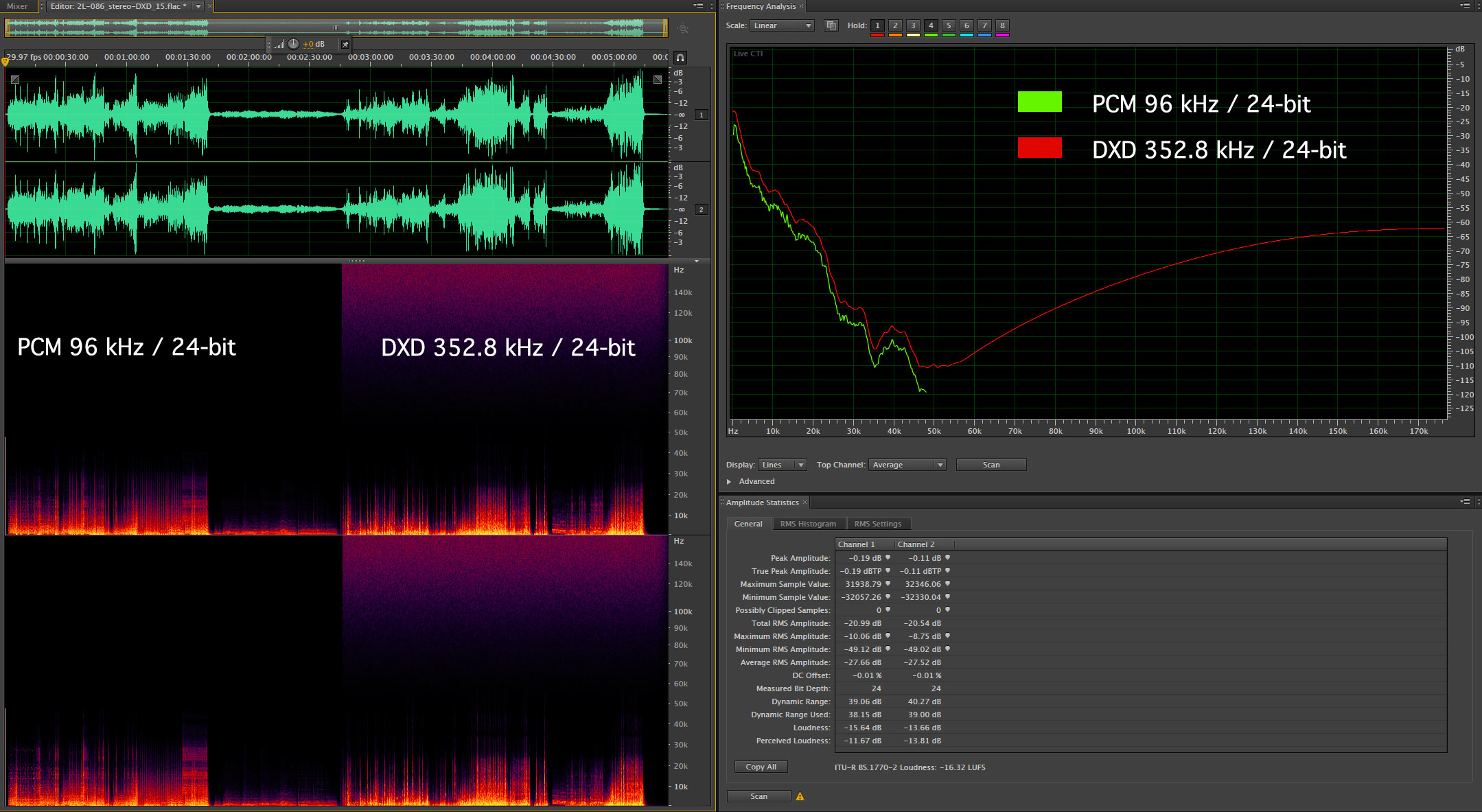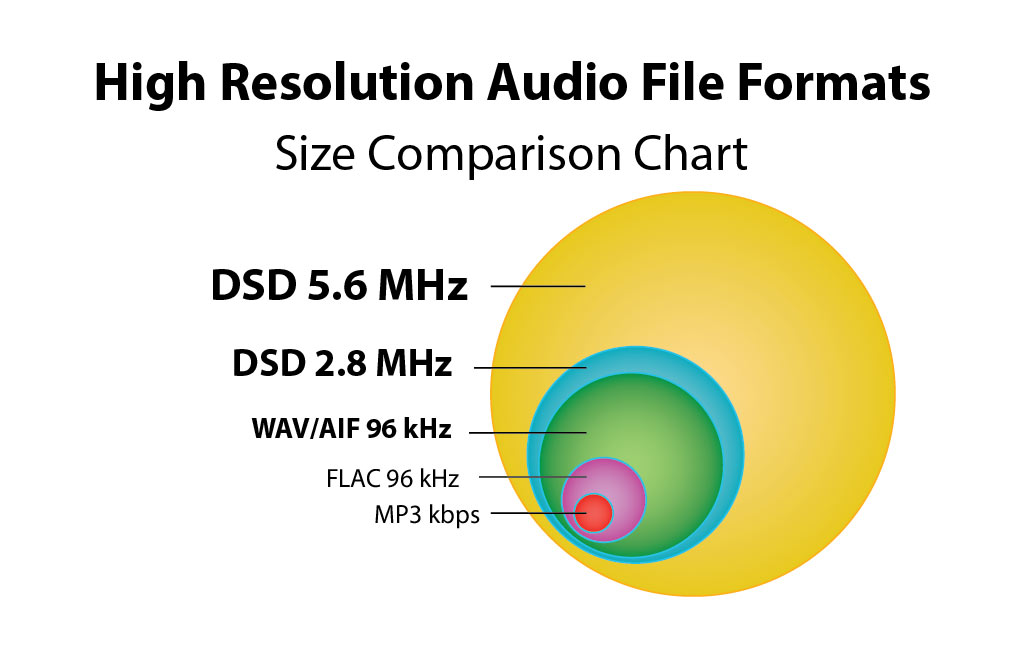DXD: PCM at 352.8 and 24-bits?
I was sitting at the breakfast table this morning and reading the most recent issue of Mix magazine, one of the premier magazines for audio professionals. It’s a slick magazine now but I can remember reading it in the 70s when it was printed on newsprint. The article on the last page was all about timing and its importance in the world of record production and audio engineering. The author wrote about hearing some tracks recorded in DXD through DAD converters running at 352.8 kHz and 24-bits. It got me thinking about my previous post and the response that I received from Claude Cellier, one of the principals at Merging Technologies, the company behind the Pyramix DAW used to record the example I tested.
Claude and I exchanged a couple of emails last fall when I authored the first post about DXD (you can review it by clicking here). He answered a number of questions I had about the DXD format, which I found very helpful and informative.
He began by explaining the reason why “extreme PCM” was developed. According to his email of last October, it was to allow the recording, editing, mixing, processing and mastering of content for the DSD portion of SACD programs in the best quality possible. So by this logic, the best quality possible for SACD (using DSD) is to record using “extreme PCM” and then downconvert to DSD 64 for inclusion on an SACD disc. Very curious.
He continued, that it was not so much about extending the frequency response but to benefit from very relaxed anti-aliasing filters, which provides extremely good transient response. This approach attenuates pre- and post-ringing due to the Analog to Digital as well as the Digital to Analog conversion processes.
So DXD was developed and is in use to facilitate the preparation of very high-quality sound intended for release in DSD. The focus is on “in band” sonic accuracy as is typical of DSD.
Last fall, I analyzed a DXD file that I downloaded and found that there was a gentle rise in high frequency noise above 50 kHz. It looked a lot like the noise that I’ve observed when evaluating DSD files…only this time it started at 50 kHz and was somewhat more gentle than the usual DSD curves.
Claude informed me that the noise was due to the AD converters and not inherent in the DXD format or his workstation. It made sense. He shared a plot that compared some converters and sure enough, some of them generate a lot of noise up there. He also informed me that newer and better converters would take care of this problem. Never mind that there aren’t any microphones that can produce output above 50 kHz.
So this morning I downloaded another DXD file, a more recent recording and decided to take a look at the spectra of both the DXD and the 96 kHz versions to see if the errant noise had been eliminated. Here’s the plot that I produced:
Figure 1 – A spectrogram of a DXD sourced recording and the downconversion to 96 kHz/24-bit PCM. The left hand plot is the PCM version and the right side is the original recording at DXD 352.8 kHz. [Click to enlarge]
This is not what I expected to see. With the new Horus converters, I was told that the ultrasonic noise would disappear. It hasn’t.
As you know, I’m headed to the T.H.E Show Newport Beach this weekend. Undoubtedly, there will be another “DSD Love Fest” on a couple of panel discussions. As DXD is the “production workflow solution” for DSD for those interested in staying the digital domain, I thought it would be interesting to take a close look at the production process that all new DSD recordings go through before release. DXD (or “extreme PCM”) is the solution to the problems inherent in DSD…yet it delivers the same fidelity as a 96 kHz/24-bit PCM recording (with appropriate care taken to reduce all digital artifacts…i.e. apodizing filters to remove pre-ringing for example).
And the PCM files are much smaller. Check out this graphic from Cookie’s Blue Coast Records site. Never mind that it seems to imply that fidelity is larger as well with DSD files…it’s not.
Figure 2 – A chart from the Blue Coast Records site showing the relative sizes of various types of sound files. Notice that DSD 2.8 (or DSD 64) is larger than a PCM 96/24 file. [Click to enlarge]
Why would anyone want to download a file that consists of 50% noise? And it’s noise that you can’t hear but could affect your electronics. Why not use the minimal amount of bandwidth and storage space to get the best possible fidelity?
I’ll attend the panel entitled, “DSD Progress Report: In the Studio – Online – In the Home” to see what’s new in the world of DSD. It’s a very big panel and populated with hardcore DSD proponents. Stay tuned for a full report very soon.




I hope “DSD Progress Report” panel discussion is shot and put up on YouTube. Would love to see, hear a real debate on this subject.
Hello Mark, I’ve been aware of your efforts since the beginning, and have great admiration for same. It’s critical IMHO that the public not be confused by differing hi-res standards and nomenclature. “24/96” is the mantra that must be drummed in to public consciousness along with ‘hi-res,’ or ‘the original sound.’I will stop by at Newport.
Best Regards,
Craig
Why do proponents of DSD like it so much? Do they honestly think is sounds better? Is there any listening comparisons in cyberspace to suggest that DSD is superior sonically than PCM or is it just another matter of subjective preference?
It’s pretty much subjective preference…and because it’s the new thing. Everyone wants something new to talk about.
Hi Bill,
I think one big ‘sell’ for DSD, that got a lot of people predisposed in its favour, was the notion that it needs no DAC, and you can get the analog output by simply applying a simple passive analog filter to its digital signal output. Hence, since the process is more analog, the result will sound more analog. (Flawed logic nevertheless has the power of being logical!)
Since a lot of the anti-digital lobby, then and still today it seems, was putting the blame for inherently ‘digital’ sound on the DAC, then a technology that seems to bypass the DAC simply must be superior, and have less ‘digital’ sound!
I hope this is some help.
Grant
I think you’re right. DSD has been sold as an “analog” technology, which it very definitely is not. If people only knew what hoops engineers have to go through to produce a “CD-quality” recording for DSD release (analog tape or DXD or PCM), they might change their minds. DSD is an audiophile format and will continue to exist but it will never become part of the general work flow in commercial studios.
Many audiophiles like DSD because it sounds more like analog, i.e. it has a warmer sound, much like LPs. I want the recordings I download to sound like the master tape, not a warmer distorted version. For me, the whole point is to be able to get the sound of the master in my home.
To each his own…
I’ve never noticed that from DSD recordings. If you want warm ‘n’ fuzzy sound, you can always cut the high treble and boost the mid-bass. There are also computer audio plug-ins that add surface hiss and snap-crackle-and-pop to digital recordings.
Look, DSD is a wonderful format if you want the “warm” analog sound. It is not so good if you want better than a CD.
Floating point sample may contain 30000 times less quantization error compared to integer…
The higher the sampling rate the thinner the quantization noise layer becomes (as known, a frequency of no lower than 1 MHz is needed to maintain timing transients).
The higher the bit depth the smaller the quantizing error footprint is.
So, a BDXL is capable of more than fifty minutes of sound in 1.536 MHz / 32 bits (almost no clipping, by the way) float / Stereo (Mono should be more acceptable).
Generally speaking, ~ 1 PHz sampling frequency is already possible and I now find that the effective resolution of modern ADCs is not necessarily limited to about 21 bits, it can be extended quite further {certainly, solely 467dB must be the very main goal}, but apart from the microphone’s 140dB limit the studio owners rather reluctant even to spend some money to properly design their recording rooms just to take advantage of the microphone’s full dynamic range.
I listened to several DXDs and they sounded disgusting if compared to both common DVD-A and some oversampled tracks incl. from CDs.
I’m not sure where you going with this…Blu-ray XL is a storage format but there’s nobody that I know of using specs such as you mention.
1.536 MHz / 32 bits float PCM is the very minimum quality for a recording to sound naturally .
As to BDXL, if you acquire recordings by downloading from net stores and if storage discs becoming unnecessary, all the more so, it is unclear why high-resolution formats haven’t still got to the abovementioned digits, especially, knowing that the internet speed could have been improved up to 400 PB/s.
DSD, on the other hand, is no sampling frequency, it’s all about simple oversampling, therefore SACD format has definitely not any advantage over a similarly oversampled/noise-shaped conventional CD that traditionally features distortion inherited from analog master tape, that’s where bad sound originates.
Yet 20-bit does not require dithering because of higher ADC’s voltage: thus, it occurs the so-called “self-dither”.
P.S. Oddly, the size comparison chart doesn’t include 24/192 OptimFROG…
Correction: 24 bits floating point / 1.536 MHz / stereo = 80 minutes of sound on BDXL .
Ramon…is there someplace online that I can read more about this? I’m interested in learning more. This run counter to much of what I know.
http://www.esstech.com/PDF/Sabre32%20ADC%20Series%20PF%20111222.pdf
Mark, is this being used in your record studio already ?
Note: device’s 32-bit capability can be useful when ADC is properly cooled .
“(as known, a frequency of no lower than 1 MHz is needed to maintain timing transients).”
No, no, no. (Sorry) ….Ramon, you have misinterpreted the research. Quite a few other audiophiles and bloggers have made the same mistake.
The research (on localisation) has indicated that the human ear/brain can discern very small changes in the timing between two signals.
This has implications for the timing requirement of audio gear. Fortunately, all digital audio has fantastic timing accuracy, better than one nanosecond. You can easily achieve the necessary timing accuracy with any sampling rate, even 1 kHz if we want to prove a point.
This has nothing to do with (sampling) frequency, as you suggest it does.
This is just another example of audiophiles choosing their equipment and eliminating other gear based on misinterpretation of research. Similar to the Oohashi (Hypersonic Effect) experiments giving people the wrong idea.
“Yet 20-bit does not require dithering because of higher ADC’s voltage: thus, it occurs the so-called “self-dither”.”
P.S. Ramon and Mark, the reason a 20-bit-or-better ADC process does not necessarily benefit from dither is because the analog input circuit almost certainly provides random noise higher than -120 dB, so the LSB is randomly switching anyway, which is the same effect as we wish to achieve with dither, hence the notion it is ‘pre-dithered’.
OTOH to omit dither for this reason is not achieving a benefit, and, if any of the studio tracks are purely digitally generated, they will need the dither added, because they have no analog input circuit.
Once a fellow who I unfortunately forget posed a great question: “If DSD measures so bad, why does it sound so good?”
I would posit that while you could take a lot of snipes at that statement, we should keep in mind that:
1) Everyone has different hearing!
2) There is a LOT we don’t know about hearing; it’s rather like the deep ocean.
I’m hardly a big proponent of DSD, mostly because I think Sony’s rollout and lack of support and internal strifing over the format was idiotic. But at T.H.E. Show the great folks at Acoustic Sounds had the Sony players set up, and I heard some WONDERFUL stuff. Some of it, like Alan Parsons’ “I Robot” I actually have in 96/24 and it does not “breathe” as much as what I heard there. (Ya, different headphones and amp, I know. But…yet…still….)
I and most others have never heard and probably will never hear a comparison of direct A/B PCM vs DSD from the same mic feed. So I kind of agnostically subscribe to what the late great John Eargle told me once when I asked him about DSD versus PCM. To paraphrase, he replied that to him (and his numerous engineering Grammies) the PCM sounded really like the original and listening to DSD did not convince him to bother with the difficulties of the format. I suspect he embodied another of my tenets: the skill and care of the recording and the room(s) etc is far more important than the technology, especially since one of the best recordings I ever heard was a recording Bruce Botnick made of James Taylor on a porch…made with a portable DAT!